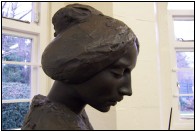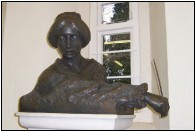| |
 
FLORA THOMPSON
 |
|
She stays
indoors nowadays, hidden from public
view, driven inside from a world she
would hardly recognise, a victim of our
mindless ways.
She is Flora Thompson, an icon of
Liphook, and its Postmistress for
thirteen years between 1916 and 1929.
Many years later she achieved fame with
the publication of her trilogy Lark Rise
to Candleford, a fictitious account of
her idyllic childhood in Oxfordshire.
|
She was born Flora
Timms on 5 December 1876 in the remote hamlet of
Juniper Hill, near Brackley, and went to school
in the nearby village of Cottisford. After four
years as a clerk in the post-office at Fringford,
she moved to Hampshire and became assistant
post-mistress at Grayshott. Here she came into
contact with two local residents, Arthur Conan
Doyle and George Bernard Shaw, who may well have
sown in her the first seeds of her own literary
career.
She lodged with the post-master, Walter Chapman,
and his wife, Emily. Chapman, also the local
furniture maker, was cruel and abusive towards
his wife, and after two years Flora handed in her
notice. This, to Chapman, was the last straw, and
soon after her departure he stabbed his wife to
death. The court found him guilty but insane.
Flora’s next job was at Aldershot, where she
met her future husband John Thompson, another
post-office worker, and in due course the couple
settled in Bournemouth, remaining there for
thirteen years, during which time their first two
children were born. Then, in 1916, came the move
to Liphook, to the old Post Office in London
Road, and two years later the birth of their
third child.
Money was always short, and Flora began to write
nature articles for The Catholic Fireside, based
on her observations in the locality, and in other
magazines and papers, culminating in 1939 with a
portrait of her childhood neighbour back in
Juniper Hill for The Lady. By this time the
family had moved to Dartmouth.
It was in 1939 too that Flora’s first great
success was published, Lark Rise, the first of a
trilogy that was to make her name. Over to
Candleford followed in 1941 and Candleford Green
two years later, all based on her experiences
during childhood and youth. They tell of Mayday
celebrations and children’s games, the lives
of farm workers and craftsmen, and paint an
endearing picture of rural life at the end of the
nineteenth century. It was a time when, even in
church, there was a strict hierarchy: the Squire
and the Parson’s families sat in the
chancel, the farmers and their families at the
front of the nave and the labourers and cottagers
at the back. The three volumes were published
together with the title Lark Rise to Candleford
in 1945, and remain her best- known work.
Flora died in 1947, and many of her hitherto
unpublished writings found their way to the
University of Texas. Eventually some of them
appeared under the title A Country Calendar and
other writings, edited by Margaret Lane.
| This
included Bog Myrtle and Peat, an
anthology of poems written at Liphook,
and Heatherly, a previously unknown novel
following on from Lark Rise to
Candleford, and describing her life at
Grayshott, in heathery Hampshire. Her image in
bronze, by the sculptor Philip Jackson
was presented to the people of Liphook by
the Bramshott and Liphook Preservation
Society, and placed outside the Sorting
Office on the south side of the village
in 1981. She was not well treated, and
suffered damage on several occasions from
mindless vandals, so now she resides in
the peace and quiet of Liphook Library,
where she was transferred in 1996.
|
|
 |
Tom Muckley, March 2006
This article was originally
published by the
Petersfield Post
tommuckley.co.uk
|
|



